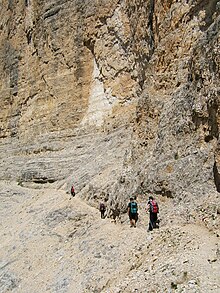Surefootedness
Surefootedness is the ability to move safely in rough terrain when hiking and mountaineering . To do this, the coordinative requirements must be met, power reserves and sufficient awareness of the terrain are also required.
Skills required
Since there is no uniform definition of surefootedness, here is a list of properties that should generally apply as the basis for surefootedness:
- Fulfill the coordinative requirements in order to move as intended on uneven surfaces without losing balance . This also means that you can compensate for a small slide in the next step without having serious consequences.
- Correct assessment of the surface, both in terms of usable steps and grip. In addition, this should be the case on all necessary types of subsoil ( rubble , rock , crags , earth, firn, etc.) and also when it is wet.
- Ability to identify the parts of the path where particularly careful walking is required due to the risk of a more serious fall.
- Correct assessment of your own coordination and performance even when you are tired and adjust your walking pace accordingly. Experience has shown that the surefootedness decreases in the afternoon due to physical and mental fatigue.
Demarcation

Surefootedness only refers to terrain that does not yet require climbing skills . People with climbing experience do not automatically have to be sure-footed. Surefootedness does not include the need for a head for heights, which is often mentioned on mountain trails together with surefootedness . The latter means being able to move around exposed passages without feeling fearful. Nevertheless, both requirements are often mentioned together, as falls on exposed passages are usually more serious due to a lack of surefootedness.
Trainability
Surefootedness can be trained , even if only within certain limits. It is best to train this on rough terrain that is not exposed. In the initial phase, sticks can help.
It should be noted that sticks actually serve to relieve the joints and should not be used to compensate for a lack of surefootedness. In addition, one should not get too used to walking with sticks, as experience has shown that this is detrimental to the surefootedness when walking without sticks (which is necessary, for example, on secured rock passages). It is advisable to refrain from using the sticks every now and then.
Surefootedness of animals
Sure-footedness is a characteristic of certain breeds, especially for horses , occasionally also for dogs or goats. The meaning is analogous to that of mountain hiking and mountaineering.
literature
- Martin Schwiersch, Dieter Stopper, Tobias Bach, Monika Ehrlich: surefootedness and stamina. In: DAV. Panorama. Announcements from the German Alpine Club. No. 3, 2006, ISSN 1437-5923 , pp. 92-95, ( digitized version b (PDF; 786.91 KB) ).
